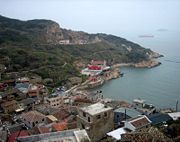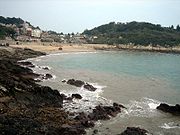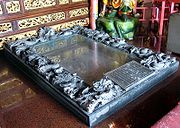
Nangan
Encyclopedia
Nangan is one of the Matsu Islands
and the capital township
of the Lienchiang County (which coincides geographically with the Matsus) of the Republic of China
.
Nangan was also known Nangantang (南竿塘; Nàng-găng-dòng) and Shanggantang (上竿塘). And because Lin Moniang's (who later became the goddess Matsu
) corpse was washed ashore here, Nangan was also known as Matsu Island (馬祖島; Mā-cū-dō̤).
There is an airport
in Nangan. The highest point is Yuntai Mountain (雲台山) (248-metre).

 There are 10 major villages located on Nangan, though they are all rather small. At the eastern end of the island is Jieshou(介壽村), the seat of the county government and the largest village. Following the coastal road west from Jieshou, there are Fuxing(復興村), Fuao(福澳村), Qingshui(清水村), Zhuluo(珠螺村), and Mazu(馬祖村). Following the mountain road west, there are Meishi(梅石村), Renai(仁愛村), and Jinsha(津沙聚落), before once again reaching Mazu. Located to the north of Mazu is Siwei(四維村). In addition to these, there are two smaller villages or clusters of homes. These are Furen(夫人村) and Ketiao(科蹄澳): they are located near Siwei.
There are 10 major villages located on Nangan, though they are all rather small. At the eastern end of the island is Jieshou(介壽村), the seat of the county government and the largest village. Following the coastal road west from Jieshou, there are Fuxing(復興村), Fuao(福澳村), Qingshui(清水村), Zhuluo(珠螺村), and Mazu(馬祖村). Following the mountain road west, there are Meishi(梅石村), Renai(仁愛村), and Jinsha(津沙聚落), before once again reaching Mazu. Located to the north of Mazu is Siwei(四維村). In addition to these, there are two smaller villages or clusters of homes. These are Furen(夫人村) and Ketiao(科蹄澳): they are located near Siwei.
Many villages on Nangan have two names. In some cases, this was the result of politics, as one is the traditional name and the second has a political connotation. These instances are paired as follows with the traditional name first: Shanlong(山隴): Jieshou(介壽), Niujiao(牛角(聚落)): Fuxing(復興), Tieban(鐵板): Renai(仁愛), and Fuao(福澳): Jingze(經澤). These names are often used interchangeably by residents, except for Jingze. Residents objected to this latter name, and so it never came into popular use. The reference to Shanlong is also important as there is a neighborhood there called Zhonglong(中隴). Mazu is also referred to as Magang(馬港) and Siwei as Xiwei(西尾). As for Mazu and Magang, Magang is the preferred name. This could be in order to distinguish the village and its harbor from Mazu(媽祖), the goddess, and Mazu(馬祖)the island chain. Xiwei was derived from the local Fuzhou dialect's pronunciation of Siwei.
 There is the Palace of Heavenly Empress (天后宮) in Matsu Village, which contains the coffin
There is the Palace of Heavenly Empress (天后宮) in Matsu Village, which contains the coffin
of Lin Moniang. The temple also include statues of the guards, Thousand-li Eye (千里眼) and Wind-following Ear (順風耳). There is an annual celebration on March 3 (lunar calendar).
Matsu Distillery (馬祖酒廠) locates on Wujiao Hill (午角嶺) in Fusing Village, producing daqu wine (大麴酒) and sorghum wine (高梁酒).
There is Shengli Water Reservoir (勝利水庫 "Victory") and a museum in Cingshuei Village. The museum contains four cannons (whose sound were to guide boat) from Jyuguang
.
There are three parks and two abandoned military tunnels on the island.
Matsu Islands
The Matsu Islands are a minor archipelago of 19 islands and islets in the Taiwan Strait administered as Lienchiang County , Fujian Province of the Republic of China . Only a small area of what is historically Lienchiang County is under the control of the ROC...
and the capital township
Township (Taiwan)
The townships are the administrative subdivisions of Republic of China counties, along with County-controlled city. Most of the present townships originates from Towns and Villages in the Japanese era. After the World War II, the ROC government reformed them as urban townships and rural townships...
of the Lienchiang County (which coincides geographically with the Matsus) of the Republic of China
Republic of China
The Republic of China , commonly known as Taiwan , is a unitary sovereign state located in East Asia. Originally based in mainland China, the Republic of China currently governs the island of Taiwan , which forms over 99% of its current territory, as well as Penghu, Kinmen, Matsu and other minor...
.
Nangan was also known Nangantang (南竿塘; Nàng-găng-dòng) and Shanggantang (上竿塘). And because Lin Moniang's (who later became the goddess Matsu
Matsu (goddess)
Mazu , also spelt Matsu, is the indigenous goddess of the sea who is said to protect fishermen and sailors, and is invoked as the patron deity of all Southern Chinese and East Asian persons...
) corpse was washed ashore here, Nangan was also known as Matsu Island (馬祖島; Mā-cū-dō̤).
There is an airport
Matsu Nangan Airport
Matsu Nangan Airport is one of the airports in Lienchiang County, Fukien Province, Republic of China . It is located on the Nangan Island, near the Jieshou Village. It also serves as a heliport.-Airlines and destinations:-External links:...
in Nangan. The highest point is Yuntai Mountain (雲台山) (248-metre).
Administration


Many villages on Nangan have two names. In some cases, this was the result of politics, as one is the traditional name and the second has a political connotation. These instances are paired as follows with the traditional name first: Shanlong(山隴): Jieshou(介壽), Niujiao(牛角(聚落)): Fuxing(復興), Tieban(鐵板): Renai(仁愛), and Fuao(福澳): Jingze(經澤). These names are often used interchangeably by residents, except for Jingze. Residents objected to this latter name, and so it never came into popular use. The reference to Shanlong is also important as there is a neighborhood there called Zhonglong(中隴). Mazu is also referred to as Magang(馬港) and Siwei as Xiwei(西尾). As for Mazu and Magang, Magang is the preferred name. This could be in order to distinguish the village and its harbor from Mazu(媽祖), the goddess, and Mazu(馬祖)the island chain. Xiwei was derived from the local Fuzhou dialect's pronunciation of Siwei.
- Jieshou literally, "Longevity for Chiang Kai-shekChiang Kai-shekChiang Kai-shek was a political and military leader of 20th century China. He is known as Jiǎng Jièshí or Jiǎng Zhōngzhèng in Mandarin....
" - Jinsha "Sand of Seaport"
- Cingshuei "Pure Water"
- Jhuluo "Pearl and Snail"
- Fusing "Revive Prosperity"
- Fuwo "Auspicious Fertility": Jingze Village (經澤)
- Ren-ai "Humanity and Love": Tieban (鐵板 "Iron Plate") until 1955 .
- Matsu "Matsu"
- Sihwei "Four Virtues"
Tourism

Coffin
A coffin is a funerary box used in the display and containment of dead people – either for burial or cremation.Contemporary North American English makes a distinction between "coffin", which is generally understood to denote a funerary box having six sides in plan view, and "casket", which...
of Lin Moniang. The temple also include statues of the guards, Thousand-li Eye (千里眼) and Wind-following Ear (順風耳). There is an annual celebration on March 3 (lunar calendar).
Matsu Distillery (馬祖酒廠) locates on Wujiao Hill (午角嶺) in Fusing Village, producing daqu wine (大麴酒) and sorghum wine (高梁酒).
There is Shengli Water Reservoir (勝利水庫 "Victory") and a museum in Cingshuei Village. The museum contains four cannons (whose sound were to guide boat) from Jyuguang
Jyuguang
Juguang , also spelled Chukuang, is a township of Lienchiang County, Republic of China. Juguang Township includes two major Matsu islands -- Dongju Island and Xiju Island -- and some islets...
.
There are three parks and two abandoned military tunnels on the island.
External links
- 12 photos
- Nangan , Lienchiang , TaiwanTaiwanTaiwan , also known, especially in the past, as Formosa , is the largest island of the same-named island group of East Asia in the western Pacific Ocean and located off the southeastern coast of mainland China. The island forms over 99% of the current territory of the Republic of China following...
, Republic of ChinaRepublic of ChinaThe Republic of China , commonly known as Taiwan , is a unitary sovereign state located in East Asia. Originally based in mainland China, the Republic of China currently governs the island of Taiwan , which forms over 99% of its current territory, as well as Penghu, Kinmen, Matsu and other minor...
.

